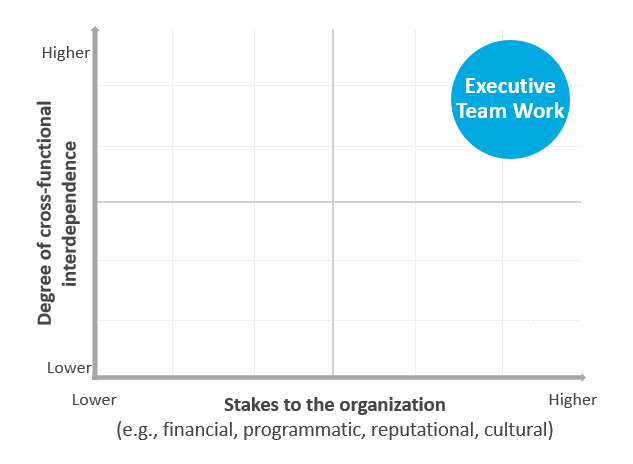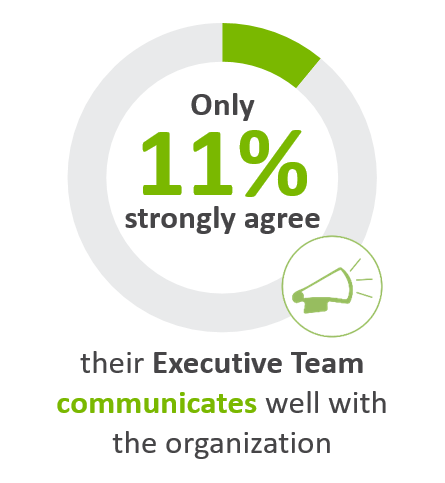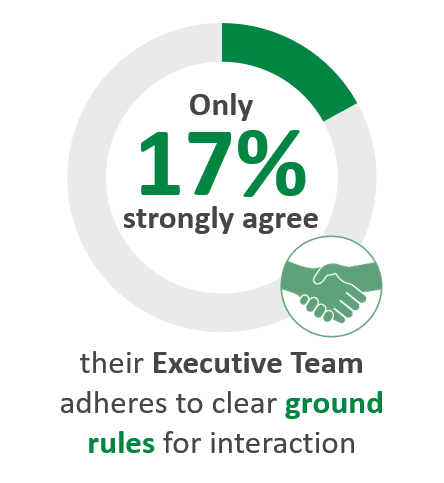(This article is adapted from Bridgespan's "How to Create Better Nonprofit Executive Teams," published on the Stanford Social Innovation Review website on October 17, 2018.).
Leading any enterprise is a challenge, especially for organizations growing in size and complexity. The job readily expands beyond the capacity of any single leader. That's why CEOs of many nonprofits establish executive teams—groups of senior leaders who work together to chart the organization's direction and keep it on track toward its goals.
Shaping a high-performing executive team is no easy task. Bridgespan's research reveals that most nonprofits falter when it comes to executive team effectiveness. Only a quarter of the 362 executive team members responding to a recent Bridgespan Group diagnostic survey "strongly agreed" that their CEO effectively addresses team dynamics and performance challenges. Only 19 percent strongly agreed that their team focuses on the right work, and just 17 percent strongly agreed that they use their executive team meeting time well.
Nonetheless, the survey also showed that roughly half of the respondents rated their team's performance as "good," or a three out of a possible four on overall effectiveness. But good isn't necessarily good enough. The upside potential of more effective CEO leadership, more clarity around the work of the team, and more productive team interactions can yield big gains for an organization—something we've seen at Bridgespan in our work over 15 years with hundreds of nonprofits. In short, the challenge is to advance from good to great.1
Our survey results came as no surprise to leadership coaches we interviewed. "Executive teams are an underperforming asset," says consultant and leadership expert Peter Thies, president of The River Group. "It's a huge investment and opportunity cost whenever you have top executives spending time together, yet executive teams tend to provide the fewest tangible results among leadership teams."
Who Needs an Executive Team?
Most nonprofit CEOs have a set of direct reports that meet regularly. At the most basic level, this group shares departmental information and receives updates from the CEO about recent decisions. While the direct reports comprise a group of senior managers, they do not necessarily work together as a team.
By contrast, an executive team takes on tasks that stand apart from the work individual members do as department heads. An executive team collaborates to shape organization-wide decisions and shares responsibility for the organization's results.
Not all nonprofits need an executive team that performs such work. For example, small nonprofits may only require a group that meets regularly to share updates. The decision to create an executive team rests on the size, complexity, and level of cross-organizational decision making required to lead the organization.
For nonprofits with an executive team, the team's effectiveness is essential for the organization's success. But despite their importance, surprisingly little has been written about them. In the for-profit arena, leadership experts have built an industry around executive leadership development and team building, though with minimal focus on executive teams. Nonprofit executive teams have gone virtually unnoticed.
Our research is informed by and builds upon the leadership and team-building work of others to address the singular needs of nonprofit executive teams.2 Our survey, a diagnostic self-assessment, received responses from 362 nonprofit executive team members. In addition, we interviewed more than two dozen nonprofit leaders and an equal number of experts or coaches from academia and consulting. We also drew on our advisory experience in five cities with more than 200 nonprofit executive teams participating in Bridgespan's Leading for Impact program, a two-year engagement that helps nonprofit executive teams hone their management skills. Out of this research, we distilled a sequence of five steps, framed as questions, that have helped most executive teams increase their overall effectiveness—even move from good to great.
Five Questions to Guide an Effective Executive Team
1. Is the CEO Effectively Managing the Executive Team?
The executive team is the charge of the CEO. As head of the organization, CEOs are accountable for results and responsible for determining what the executive team must do to achieve those results. This played out in our survey, interviews, and in our experience with clients: in high-performing executive teams, the CEO takes charge of the team's form and function.
Specifically, these CEOs set expectations and define the executive team's work, steer meeting agendas, and support team members to grow while holding them accountable for performance. Managing the team does not require doing all of the day-to-day work of team coordination. In fact, many CEOs choose to delegate certain tasks to a deputy or other executive team members, such as getting input on potential meeting agenda items. CEOs with strong team players can even delegate leadership roles by assigning individuals as stewards for specific topics central to the team's work, such as diversity efforts, talent development, communications, or budgeting.
However, effective delegation does not mean abdication. To be effective, the CEO must maintain ultimate decision-making authority over what the team focuses on and how they do their work, while fostering strong relationships with team members.
Managing an executive team effectively also requires that CEOs should understand their own decision-making style and preferences and set clear expectations on which decisions will be their call (or another team member's decision) based on team input and discussion and which will be consensus decisions. Once those ground rules are established, it's important to follow through on those expectations. Lack of clarity or inconsistency here can create problems for the team, such as when a CEO seems to guide a team toward a consensus decision only to exercise a pocket veto if the decision wasn't what the CEO personally preferred.
Many nonprofit CEOs lack the experience to perform their role as executive team leader. Nonprofit boards often prioritize external capabilities, such as fundraising or advocacy, over internal leadership skills when they search for CEO candidates. And even those who have strong internal capabilities are commonly stretched thin. As a result, it's not surprising that only one in four survey respondents strongly agreed that their CEO addresses team dynamics and performance challenges in a timely and effective way.
Skillful team management makes a big difference. The executive coaches we spoke with agreed that CEO leadership was the single most important factor in making teams highly effective. "The CEO sets the tone for the executive team," says Leslie Bonner, an adviser to nonprofits and a leading expert on nonprofit leadership. "If they don't prioritize the team's work or embody the productive behaviors required to do that work, it is very difficult for the team to work effectively." CEOs also set the culture of the organization "by identifying the underlying values that support the organization's mission," says Maria Hernandez, practice leader with InclusionINC, a global consulting firm specializing in inclusion and diversity. "People can be organized around great task management and great processes, but miss the mark on living the vision and mission of the organization that is to serve a diverse community."
2. Is the Executive Team Focused on the Most Important Work?
Getting clear about the most important things for the team to focus on—and just as important where it shouldn't spend its valuable time—is critical in determining who should participate and how the team should conduct its business. Clarity, however, eludes many teams. Only 19 percent of our survey respondents strongly agreed that their executive team focuses on the right work. One CEO put it this way: "Many teams end up sharing random, miscellaneous stuff, as opposed to things that are thorny and really either advancing or hindering strategy."
Typically, the right work involves guiding the organization toward achieving its top priorities and ensuring effective cross-departmental decision making and resource allocation. The executive team also provides an effective forum for input and discussion that helps the CEO make better decisions. In short, executive teams help CEOs do their job of leading the organization.
The team, however, doesn't necessarily need to play a role in all of an organization's priorities. Some may best be addressed by the CEO alone (like strengthening key funder relationships) or in consultation with specific departments or functions (like making specific programmatic decisions). As organizational behavior expert Ruth Wageman puts it, the trick is to determine "what are the critical few things that only this team of senior leaders, of all people in this organization, need to accomplish together versus individually or by other groups?"
Executive teams can home in on the handful of critical areas by focusing on those issues that meet the following two criteria:4
- What issues are the most interdependent? (Those involving multiple units or functions where cross-leader discussion is critical for effective decision making.)
- What issues have the highest stakes? (Those having the most impact on the organization’s strategic clarity and priorities, programmatic and organizational effectiveness, development of future leaders, external reputation, and financial sustainability.)
Identifying the Work of the Executive Team
The hours the executive team spend together are the most expensive on the payroll. The more the executive team focuses on issues that are highly interdependent and have the highest stakes, the greater the return on investment the executive team will have for the CEO and the organization.
Once an executive team has clarity about its work, it needs to determine what role it will play in that work. For some issues, the team's role will be to provide input on a decision that someone else (either the CEO or other individual or team) is responsible for making. For others, the team may make a decision itself. It is likely the team's role will differ by priority, or even by specific elements within a priority, so continuing to clarify what role the team is playing is critical to optimizing the team's time together.
3. Does Executive Team Composition Support Its Ability To Do the Work?
CEOs who rated their teams as highly effective balanced two critical questions:
- Does the team have the key perspectives and competencies to do its work?
- Is the team a manageable size?
Finding the right combination of perspectives and competencies may not result in a team composed only of the CEO's direct reports. While it's critical that all executive team members be able to take a big-picture perspective and have business acumen, CEOs may choose to include non-direct reports whose unique skills are essential to the team's work. For instance, executive teams may include the director of human resources or a director of measurement and learning even if these individuals do not report directly to the CEO. Diversity among executive team members is another critical consideration. Currently, most nonprofit executive teams systematically under-represent people of color and do not reflect the diversity of the communities their organizations serve. This issue has drawn increasing attention, with stepped-up efforts to address it.5 (See "Spotlight: Diversity, Equity, and Inclusion" at the end of the article.)
Including all the right perspectives can sometimes be at odds with keeping the team a manageable size. In fact, many nonprofit executive teams are too big. Almost a third of survey respondents reported having eight or more members, the upper limit of what research has found to be an ideal team size to have effective strategic discussions and team cohesion.6 A common rationale for a large executive team is to increase inclusion and ensure leaders across the organization stay informed and coordinated. In these instances, CEOs could consider having two leadership teams—a smaller executive team for making critical organization-wide decisions, and a larger management team for maintaining coordination among departments. Executive and management teams should continually seek to augment their expertise and perspectives by gathering input from stakeholders (such as staff, clients, community members) central to the issues on which they are working.
Whatever the team's size, changing who sits at the table is difficult, but maintaining a status quo that isn't working comes at a greater cost to team and organizational effectiveness. Significant change events, such as the arrival of a new CEO or strategic pivots, present opportunities for reconsidering and altering a team composition. Many CEOs told us, however, that they wished they hadn't waited for the perfect time to make changes, particularly when it came to removing detractors who held the team back.
4. Do Meeting and Communication Processes Support Superior Decisions and Execution?
Well-managed processes around meetings and internal communications are essential for a successful executive team. "Meetings are the lynchpin of putting this all together," says Pat Lencioni, a best-selling author on leadership and organizational health. "They're the place where everything else comes to life, and where you demonstrate whether you are an effective team or not." Yet, ineffective meetings and poor staff communications stood out as major pain points in our survey. Only 17 percent of our survey respondents strongly agreed that they have effective meetings, and only 11 percent said they communicate well with the rest of the organization.
Effective meetings require establishing the right practices, such as sufficient advance notice, clear purpose, the right amount of time and right location, and, often, pre-reads to prepare everyone for productive discussions. The most productive use of time also requires management of agendas to ensure that the urgent—immediate or unanticipated problems—doesn't consistently crowd out the high-priority work the team needs to do.
Effective teams use different types of meetings for different types of work.7 Regular weekly or bi-weekly check-ins are effective for sharing updates and addressing immediate issues. Teams often need longer, less frequent planning meetings to wrestle with important decisions or dive deep on ongoing issues, such as developing talent or budgeting. Sometimes teams may need day-long or multiday retreats for team building, annual planning, or strategy sessions. The timing and cadence of these different types of meetings should be planned around the organization's calendar, including talent reviews, budgeting cycles, and board meetings.
Effective executive teams tend to conclude their meetings with agreement on decisions and actions, and a plan for following up and communicating with staff. Doing this well builds trust in the leadership, generates clarity around organizational priorities, and improves overall execution.8 Yet, our survey respondents gave executive team communications with the rest of the organization the lowest rating of all the questions we asked.
"Productive action begins with productive communication," says Dekkers Davidson, a strategy consultant and former CEO of companies large and small. "You have to be sure your communication is actually building alignment between the executive team and the rest of the organization." To build alignment through communication, CEOs and experts we interviewed said that executive teams can connect ongoing updates and decisions back to the organization's top priorities, and communicate overall progress against these priorities several times a year.
5. Does the Team's Dynamic Foster the Right Conversations and Results?
Building a cohesive executive team is essential for organizational success. A cohesive team also sets the tone for the rest of the organization, modeling the importance of collaborative behavior. Thirty-six percent of survey respondents strongly agreed that their executive team members work well together, higher than most survey responses. Even so, our interviews suggest that many teams underinvest in developing a productive working dynamic tailored to their specific work, expecting this to happen without intentional effort. "When people are together just by virtue of sitting next to each other, that is not enough to make a team," says Maria Kim, CEO of Cara Chicago, a $10-million workforce development social enterprise with 80 employees. Organizational strategy adviser and best-selling author Jon Katzenbach underscores that, "the successful teams we've observed all gave themselves the time to learn to be a team."
"When people are together just by virtue of sitting next to each other, that is not enough to make a team."
Executive teams often must grapple with a pervasive culture of conflict aversion—a characteristic typical of nonprofits. In interviews with executives of nonprofit organizations, we frequently heard that team members hesitate to question a colleague's view or openly disagree. This reticence reflects a common nonprofit ethos of "we're all in this together" so don't rock the boat. But conflict aversion can come at a significant cost. Not only does the team miss out on the opportunity to wrestle together with hard questions, but disagreements can surface in hallway conversations, breeding mistrust.
Our research identified a set of dynamics that support productive engagement for an executive team:
- Shared ownership: Joint responsibility for agency-level tradeoffs and decisions beyond the work of an individual's department
- Trust: Psychological safety that enables interpersonal risk taking and confidence that the team will not embarrass or punish someone for speaking up
- Constructive conflict: Comfort with and encouragement of diverse perspectives and productive disagreement as necessary ingredients to innovation and good decisions
- Collaboration: Active listening, building on and connecting the ideas of others to solve each other's problems
- Accountability: Commitment to team processes, the decisions of the team, and holding each other accountable for expected performance
- Equity and inclusion: Shared commitment to elevate underrepresented voices, value diversity, and understand and disrupt bias and privilege in the team and its work, and in the organization's culture
Once the team has agreed on a set of key behaviors, they hold each other accountable for sticking to them—a process the CEO leads and models. For example, to promote constructive conflict, team members might agree always to generate several meaningful alternatives to ensure they don't fall into group think. Finally, effective executive teams continue to invest in building personal relationships with each other in and outside of their formal interactions.
Putting Effective Practices into Action
Only one in four of our survey respondents rated their executive team highly effective. If your team is among the other 75 percent, imagine the productivity boost for your organization, and you personally, if the team were to advance from good to great.
Effective executive teams help CEOs do a better job of leading the organization. But it's up to the CEO to chart the team's course and manage its journey. Every executive team success story we've seen in our research and client advising work was spearheaded by a proactive CEO.
Just as important, when an executive team is humming, each member benefits. They gain greater visibility across the organization, which informs their own work. And they participate in and learn from rigorous decision-making practices they can then bring to their own part of the organization.
The benefits are clear. Investing in executive teams can pay dividends for organizations and for their impact in communities they serve.
Libbie Landles-Cobb and Kirk Kramer are partners in The Bridgespan Group's Leadership Practice and are coauthors of "The Nonprofit Leadership Development Deficit," SSIR.org, October 22, 2015. Henry Barmeier is a manager in Bridgespan's San Francisco office.
The authors thank Bridgespan colleagues Rachel Heredia, Nathan Lazarus-Gardner, Leslie MacKrell, Preeta Nayak, Micaela Owen, Bob Searle, and Roger Thompson for their contributions.
Spotlight: Diversity, Equity, and Inclusion
Executive teams at nonprofit organizations typically don't represent the diversity of the communities they serve or even of their staff. Among organizations that took our diagnostic, one-third have no people of color on their executive team. Prior surveys by Compass Point and The Meyer Foundation9 and by Board Source10 have also found that fewer than 20 percent of nonprofit CEOs are people of color. Yet researchers have determined that leadership diversity isn't just important from a representation standpoint. It also contributes to better decisions and stronger outcomes.11
The nonprofit leaders we've worked with, and the CEOs and leadership coaches we interviewed, are well aware of the need for more diversity on executive teams, especially when it comes to race and ethnicity. They described a variety of efforts to increase team diversity and guide their organizations to make equity a core value:
Make a strategic commitment to hire, promote, and support people of color: CEOs determined to improve the diversity of their teams and organizations put resources and accountability behind their commitment to equity. This can include, for example, setting hard targets for recruiting and retaining people of color and actively tracking and reporting progress, and requiring a certain percentage of candidates for jobs be people of color. "When executives understand that their performance evaluation is linked to inclusive workplace cultures, you will see a more concerted effort to actually do the hard work," says Maria Hernandez of InclusionINC.
Increase equity competencies in all team members: Having a diverse team is not good enough. Everyone on the executive team needs to take accountability for leading a diverse and equitable organization. This requires helping individuals on the team build their skill and comfort in behaviors like seeking out and valuing diverse perspectives, creating a culture of inclusion, and mitigating bias (explicit and unconscious) that create barriers for people of color. Trainings on topics like how to counteract unconscious bias can help increase awareness, understanding, and competency on these issues.12 Training also promotes a culture of vulnerability where team members self-correct when they recognize themselves making unfair judgments and assumptions.
Embed equity in executive team decision making: In making decisions, an equity-focused executive team doesn't necessarily have to achieve consensus. However, it's important to be transparent about decision-making processes and ensure inclusive input. Make time in discussion to draw out and amplify diverse points of view on the executive team.13 In weighing options, it's also important to consider differential impacts of any decision on people of color.14










